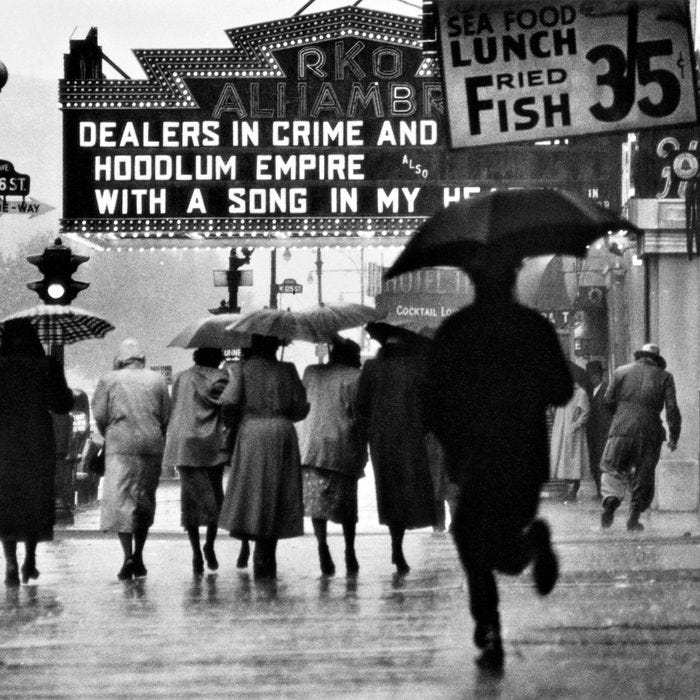Life lesson - fire hydrants are heavy

A few years ago we were walking home, and I saw a fire hydrant on the sidewalk. It was not in the sidewalk as one usually sees a fire hydrant but on the sidewalk. It looked like a car, a truck, or something had hit it. Any damage to the vehicle that hit it had been cleaned up, but the fire hydrant? That was lying there on the sidewalk. I decided to pick it up and carry it home. I picked it up. Sort of. I did not carry it home. Fire hydrants are heavier than they look.
-Anyway, I tried to include more things in this edition. Going forward, my plan is to include more types of interesting things. Some will be timely, some will be “classic.” All will be things that interest me.
Anyway, share if you can, or would like.
Maybe the best thing I’ve read about the death of Jordan Neely
Jordan Neely Just Needed Some Help from Albert Burneko via Defector - “At 30 he had no place to live. He was hungry and thirsty and tired and upset. He was experiencing a whole stack of separate crises piled onto each other. He walked into a crowded subway car carrying those crises; one of the people there decided that the problem, in that situation, wasn't that Jordan Neely was hungry or thirsty or tired, or that he was in obvious distress, but rather that on top of those other things he was also breathing, and killed him.”
A movie to watch
Directed John Huston after the end of WWII and not seeing the light of day until 1980, “this documentary depicts the effects of war by focusing on American soldiers who are suffering from mental trauma after their tours of duty. The movie follows numerous hospitalized veterans as they receive psychiatric care for their various symptoms, which include depression, phobias and antisocial behavior. As the soldiers undergo treatment, many of them make progress and slowly begin to reclaim their lives.”
A good profile
Maybe it’s me, but it feels as if folks are getting ready for Paul Schrader, who is 76, to either die or stop making movies. I don’t think either is going to happen soon. However, if it inspires strong profiles like this one on Schrader from the New Yorker, that’s fine.
Some art
Painting by Ivan Albright: Picture of Dorian Gray, 1943-1944
Media not really concerned about Proud Boys working with FBI
“That fact doesn’t just make the FBI’s failure to detect and prevent the Capitol riot even more baffling. Revelations from the trial suggested that the FBI’s historical and ongoing fixation on left-wing protests potentially blinded it to the threat of the far right, and that the bureau is even happy to collaborate with far-right groups as a way of neutralizing what it sees as a greater threat from the Left.” via Jacobin.
A podcast to listen to
Errol Morris speaks to Brin-Jonathan Butler.
A classic Ad
Question “expert” witnesses
The book, Junk Science and the American Criminal Justice System, was an eye-opener, and I recommend it. One takeaway from reading it was that “expert witnesses” really only need to convince a judge they are experts. Once that convincing is complete, the jury and the public tend to defer to these “experts".” We shouldn’t.
This story from ProPublica is another look at “expert witnesses” that might not deserve that title.
Read it before the movie
This as an excerpt from, “Killers of the Flower Moon: The Osage Murders and the Birth of the F.B.I,” The movie, which was directed by Martin Scorsese, comes out later this year. Here’s what the story is about, “In the early twentieth century, the members of the Osage Nation became the richest people per capita in the world, after oil was discovered under their reservation, in Oklahoma. Then they began to be mysteriously murdered off. In 1923, after the death toll reached more than two dozen, the case was taken up by the Bureau of Investigation, then an obscure branch of the Justice Department, which was later renamed the Federal Bureau of Investigation. The case was among the F.B.I.’s first major homicide investigations. After J. Edgar Hoover was appointed the bureau's director, in 1924, he sent a team of undercover operatives, including a Native American agent, to the Osage reservation.”
Read this short piece from the book: “The Marked Woman: How an Osage Indian family became the prime target of one of the most sinister crimes in American history.”







